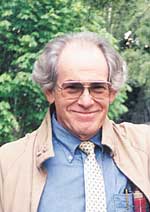DEGREE
in DEMAND
‘A
REAL CHALLENGE’
GARDEN
VARIETY APPLICATION
 regon
State University is preparing to offer Bachelor of Science degrees
to students majoring in computational physics in order to satisfy
the exploding demand for university-trained computer specialists.
Rubin Landau, a physics professor and director of the Computational
Physics for Undergraduates program at Oregon State, designed the
curriculum for the degree–the second of its kind in the United
States. With the support of SDSC and NPACI, Landau has received
the endorsement of the Department of Physics, the university provost,
and the chancellor of the Oregon University System–support
that paves the way for final approval at the October meeting of
the Oregon Board of Higher Education. regon
State University is preparing to offer Bachelor of Science degrees
to students majoring in computational physics in order to satisfy
the exploding demand for university-trained computer specialists.
Rubin Landau, a physics professor and director of the Computational
Physics for Undergraduates program at Oregon State, designed the
curriculum for the degree–the second of its kind in the United
States. With the support of SDSC and NPACI, Landau has received
the endorsement of the Department of Physics, the university provost,
and the chancellor of the Oregon University System–support
that paves the way for final approval at the October meeting of
the Oregon Board of Higher Education.
 |
|
Rubin
Landau
|
SDSC and NPACI provided
one-month summer appointments to help Landau develop his curriculum.
"In many ways, I couldn’t have won this approval without
the help of SDSC and NPACI," said Landau. "More than
having their financial support, having the personal endorsement
of the leaders of these national organizations helped me win this
authorization." DEGREE
IN DEMAND Many companies could
use more college graduates trained in computational science to
model ground-water movement or to help design cars, aircraft,
and other transportation equipment. "Unfortunately, there
are not enough information technology workers to meet the demand,"
said Landau. Illinois State University
is the only other university in the United States known to offer
a bachelor’s degree in computational physics, according to
the American Institute of Physics. (Several other universities
offer bachelor’s degrees in physics with minors or specialties
in computational physics.) In partnership with
NPACI’s Education, Outreach, and Training program and a three-year,
$600,000 grant from the National Science Foundation, Landau bought
40 Sun computers to create a low-budget, yet powerful, 20-node
Beowulf cluster. Landau cools his computers with a window air
conditioner. Graduate students gain invaluable experience serving
as system administrators. "We’ve learned how to make
do with a shoestring operation," he said. NPACI’s Education
Center on Computational Science and Engineering at San Diego State
University also provided high-performance computing and research
tools to Landau’s program. The tools were developed for research,
visualization of data, and interactive collaborative environments.
‘A
REAL CHALLENGE’ Landau has written
three physics textbooks, including Computational Physics: Problem
Solving with Computers. He began offering computational physics
classes to seniors 10 years ago, and in 1997 he began offering
versions of these classes to freshmen. Students use Web-based
tutorials and demonstrations and textbooks. The courses require
proficiency in physics, computer science, and applied mathematics
to solve real-world problems. For their assignments. students
receive codes developed by graduate students at Oregon State.
"The students have two to three weeks to get a feel for the
research and how to do simulations," said Landau. "It’s
a real challenge." Most physics students
in United States colleges use computer-simulation software such
as Maple and MatLab; however, Landau says many don’t understand
the computer science involved. At the same time, computer-savvy
undergraduates don’t always find science courses that suit
their highly developed multimedia tastes. "When I was an
undergraduate more than 35 years ago, I realized that computing
had to be woven into the fabric of science education," said
Landau. "Of course, it’s often hard to provide interdisciplinary
programs at most universities." GARDEN
VARIETY APPLICATION Oregon State recently
hired Christopher Sullivan, one of Landau’s undergraduates,
as manager of its Biology Computing Center. KwangChul Oh, a Ph.D.
student in the Department of Botany and Plant Pathology, had determined
the nucleotide sequence of a section of a tomato chromosome that
contains a gene called dgt. The gene’s biochemical function
was unknown, and Oh wanted to discover it. So Sullivan wrote a
program that compared Oh’s tomato DNA to the genomes of other
plant species. Just as Oh had hoped, the comparison identified
the dgt gene as one that helps the plant respond to a growth hormone.
"Chris was indispensable," said Oh. Tomatoes account for
$1.7 billion in annual U.S, farm income, second only to potatoes
among all fruits and vegetables. Oh hopes the results of his research
can be used to develop higher yielding tomatoes and other agricultural
crops. Landau is not surprised
that one of his computational physics students played such an
important role in a plant-research project. "Many big users
of supercomputers are involved in biological research," he
said. "I’d like other university departments to use
the same tactic that I’ve used to create programs in computational
biology, computational chemistry, and computational mathematics."
–RG 
|

